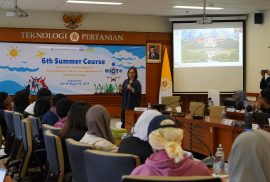The field trip began with students boarding two buses. Our first stop was near Selopamioro to pick up snacks, which included sweet potatoes, krupuk-like snacks made from potatoes, pudding, and a type of bread with cheese. The variety of flavors was interesting, and the iced tea was refreshing.
After enjoying the beautiful scenic views of Bantul along with our snacks, we arrived at the main crop fields. There, we saw farmers and vast fields ready for planting seeds. We were divided into two groups: Group 1 consisted of participants from Groups 1, 3, and 5, while Group 2 included those from Groups 2, 4, and 6. Each group was guided by a local farmer to plant onions.
The land was in good condition, and we were instructed to plant eight onions in a single line, leaving about 10 centimeters between each one. It was a fascinating experience, and we bonded well while learning words from different languages. One interesting aspect of the local culture was their practice of sharing water ponds and farming tools.
We also observed the water reserves, where rainwater collected from higher elevations is used for farming. The system can be utilized during dry spells, thanks to an IoT-based rain calculation system installed by FTP UGM. This system helps farmers predict rainfall adequacy for crops and manage irrigation efficiently. While gravity mainly transports water, diesel pumps are gradually being replaced by electric ones to reduce costs. Previously, farmers could only harvest once a year, but now, with these practices, they can cultivate paddy and tobacco twice a year.
During the field trip, an interview was conducted with Pak Tuh Gimin, a local farmer. Pak Tuh Gimin has three children, all of whom are married and also work as farmers. His farming group manages a total of 120 hectares of land, which is divided among the members, with each receiving around 1,000 square meters, though the exact amount can vary.
According to Pak Tuh Gimin, the farming schedule is as follows:
- September, October, November: Vegetable season (“sayur”).
- January, February, March, April: Paddy season.
- April, May, June: Red onion (“bawang merah”) season.
This seasonal rotation allows the farmers to maximize the productivity of their land throughout the year.
After leaving the farm with wonderful memories, we arrived at Sekolah Sungai Siluk, where we had lunch. We then participated in an engaging gamelan class. The participants quickly learned to synchronize their playing, which was impressive.
We have gamelan class that we find interesting. We learned a lot about tempo, music note, and we learned how to play gamelan. At first it was hard to play. but after some adjustment gamelan seems so interesting and became a cool stuff we learned here. Also, gamelan is one of the most famous traditional music in Indonesia. We played a ‘gugur gunung’ song.
After the gamelan class, we made Es Telang, a drink made with Telegah flowers, coconut jelly, lychee jelly, basil seeds, ice, and lemon. The Telang flower comes in three colors: blue, pink, and white. It is easy to grow and offers numerous health benefits, such as being an antioxidant and helping with eye infections, inflammation, diabetes, and cholesterol. The flower is also known for its anti-aging properties. A fascinating feature is its color-changing ability when lemon is added: the blue flower turns purple, the pink turns blue, and the white remains unchanged.
The Telang flower is abundant in Selopamioro village, and FTP UGM has collaborated with the community to promote its benefits. The drink is easy to make and rejuvenating. I hope to try the Es Telang Herbal one day, as I am curious about its taste, which includes different ingredients. Typically, two to three flowers are needed to make 250 ml of water, and they can be either boiled in water or added to boiling water.
After enjoying the Es Telang, we boarded the buses for the journey back to FTP UGM.

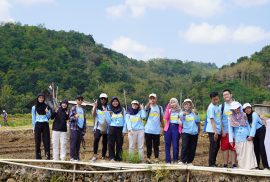
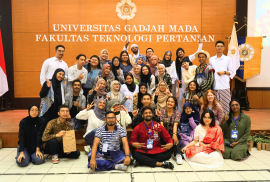
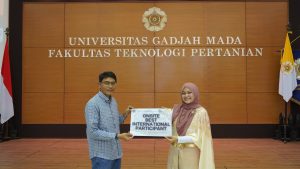 The next agenda was lunch break until 13.00. After that, the participants prepared themselves for the closing ceremony and country performance. Around 15.00 all participants gather in FAT Convention Hall to attend the closing ceremony including Dean of Faculty of Agricultural Technology, Universitas Gadjah Mada, Prof. Dr. Eni Harmayani, representative of Directorate of Partnerships and Global Relations UGM, Dr. Wiratni, Vice Dean for Academic and Student Affairs, Prof. Dr. Yudi Pranoto, Vice Dean for Finance, Assets, Human Resources, and Information System, Prof. Dr. Kuncoro Harto Widodo, Vice Dean for Research, Community Services, Cooperation, and Alumni, Dr. Sri Rahayoe, chairman of the 6
The next agenda was lunch break until 13.00. After that, the participants prepared themselves for the closing ceremony and country performance. Around 15.00 all participants gather in FAT Convention Hall to attend the closing ceremony including Dean of Faculty of Agricultural Technology, Universitas Gadjah Mada, Prof. Dr. Eni Harmayani, representative of Directorate of Partnerships and Global Relations UGM, Dr. Wiratni, Vice Dean for Academic and Student Affairs, Prof. Dr. Yudi Pranoto, Vice Dean for Finance, Assets, Human Resources, and Information System, Prof. Dr. Kuncoro Harto Widodo, Vice Dean for Research, Community Services, Cooperation, and Alumni, Dr. Sri Rahayoe, chairman of the 6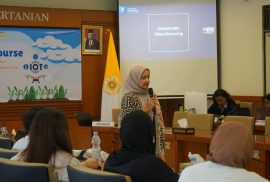
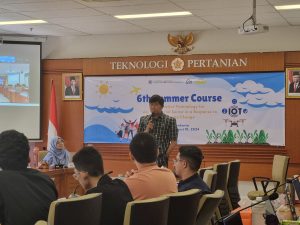 There were 4 speakers, 2 online and 2 on-site. The first lecture was on International Agricultural Development and Cooperation from Korea’s Perspective, moderated by Sintia Putri Pradita, M.Sc. from FAT UGM. Taeyoon Kim, Ph.D. from Seoul National University South Korea, explained about agricultural development especially related to GDP per capita with rural populations in Asian countries such as Japan and Korea from 1960 until now. He mentioned an example of food value implemented in the USA and agricultural contributions such as source of labor for the modern sector, saving for investment, foreign exchange through export, etc.
There were 4 speakers, 2 online and 2 on-site. The first lecture was on International Agricultural Development and Cooperation from Korea’s Perspective, moderated by Sintia Putri Pradita, M.Sc. from FAT UGM. Taeyoon Kim, Ph.D. from Seoul National University South Korea, explained about agricultural development especially related to GDP per capita with rural populations in Asian countries such as Japan and Korea from 1960 until now. He mentioned an example of food value implemented in the USA and agricultural contributions such as source of labor for the modern sector, saving for investment, foreign exchange through export, etc. 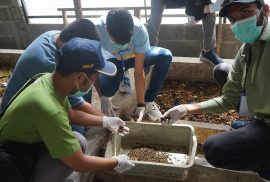
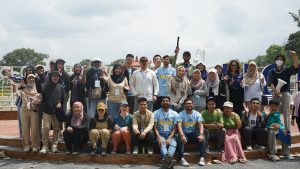 Manufacturing Bottle Caps Using Recycled Materials
Manufacturing Bottle Caps Using Recycled Materials